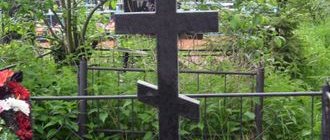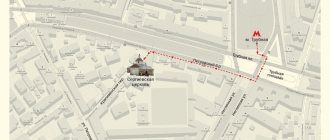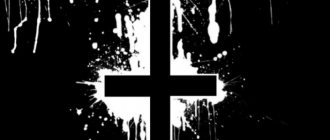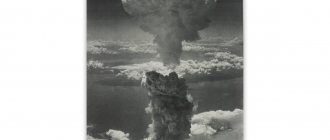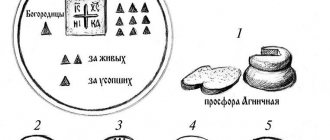How the tradition began
The Truvorov cross of the 14th-15th centuries, white stone, is located on the outskirts of the ancient cemetery in Izborsk, next to the so-called Truvorov settlement. Local legend says that this cross marks the grave of Truvor, the legendary Varangian prince who died, according to chronicles, in 864. The height of its ground part is more than 2 meters.
The tradition of putting up crosses arose in Rus' even before its baptism in 988. According to the “Tale of Bygone Years” by Saint Nestor the Chronicler, the holy Equal-to-the-Apostles Princess Olga “began to destroy the temples and idols and began to erect the crosses of Christ in those places; The crosses of Christ continue to work signs and wonders to this day, where the saint placed them.” Equal to the Apostles Prince Vladimir also followed the tradition of erecting crosses. Crosses were installed at the founding site of a city, church, monastery, or fortress - this testified to the consecration of the place and the request from the Lord for blessings to begin construction.
As for the origin of this tradition, then, apparently, it came to Rus' from the Czech Republic and Moravia, where Saints Cyril and Methodius preached. In general, I note that the tradition of erecting memorial crosses is common to all of Eastern Europe - both Orthodox and Catholics. The forms of the cross differ, but the motivation is the same: asking the Lord for protection, thanking Him for his help and calling on people to remember God once again. In Rus', the tradition of putting up crosses was most developed in the North, on the coast of the White Sea. Apparently, because in the Middle Ages it was an outpost of Orthodoxy, the Russian people developed these spaces in a struggle with both difficult natural conditions and the pagan culture of the autochthonous peoples of the North. According to P.V. Boyarsky, there was a “war of religious symbols” - crosses were erected where idols had previously stood.
In addition, if by Russia we mean precisely the world of Russian Orthodox culture, and not the Russian Federation within its current borders, then one cannot help but say about Ukraine. There, the tradition of erecting crosses, especially roadside ones, has always been extremely popular, and, by the way, local residents show more respect for such crosses than many of our compatriots.
Literature[ | ]
- Panchenko V. B.
Wooden worship crosses of the Volkhov region: Deciphering the main cryptograms found on the Ladoga crosses. Catalog. - St. Petersburg: Kalamos, 2021. - 64 p. — 1000 copies. — ISBN 978-5-905836-29-9. (Review) - Gureev E. M.
Worship crosses of the Russian North of the XVI-XVII centuries. : review of domestic historiography // Bulletin of PSTGU. Series II: History. History of the Russian Orthodox Church. 2021. Issue. 81. pp. 11-23.[1][2] - Worship cross from the village of Tolmachi: Results of restoration / Comp. A. S. Makarova, O. E. Trufanova; Auto. texts: M. B. Mindlin, S. V. Gnutova, A. S. Makarova, O. E. Trufanova, R. V. Lobzova, I. F. Kadikova. — M.: Central Museum of Ancient Russian Culture and Art named after Andrei Rublev, 2021. 64 pp.[3]
For what purpose?
Ancient ascetics, when they came to a deserted place, put a wooden cross there - thereby sanctifying this desert, testifying to the grace of God and casting out demons. This is known from the many lives of Russian saints.
However, crosses were erected not only by holy ascetics, but also by ordinary people from different classes - from kings to serfs.
Crosses were erected, for example, for worship in places where there were no temples or chapels. Local residents gathered at such crosses and prayed to God; such crosses reminded travelers of God. Security crosses were also placed - in fact, such crosses were the visible embodiment of a prayer to the Lord for deliverance from all evil. Crosses were also placed on personal vows - say, in gratitude for healing, for deliverance from a pestilence, for salvation from death. Alekseevsky Cross Placed in the 1380s in Novgorod by order of Metropolitan Alexy of Moscow.
Historians suggest that this cross is both a worship and a memorial cross - erected in honor of the victory over the Tatars on the Kulikovo Field. Carved from a single white stone block. During the Great Patriotic War he was kidnapped by the Germans and then returned. Now located in the St. Sophia Cathedral of Veliky Novgorod. The Pomors, by the way, also put up crosses as a sign of spiritual war with the paganism of the northern peoples - the Nenets and Sirtya (a people who were either destroyed by the Nenets or assimilated by them by the 17th century). Let me quote from the work of P. V. Boyarsky “The Russian Cross in the Sacred Space of the Arctic,” published in the first issue of the Stavrographic Collection: “Here, for centuries, a special Orthodox island culture of sailors took shape, with powerful support from the Solovetsky Monastery. And the maritime “crossroads” have demanded their own type of boundary crosses on islands, archipelagos and the Arctic coast. Votive, noticeable, worship, memorial and grave crosses on the coast performed a variety of functions, sometimes deeply different from the intentions of those who erected them. In many Northern Russian legends, the island was perceived as a habitat for foreigners, as the sacred center of an alien world. It was as if there was a border between life and death here. And the mortally dangerous path across the sea of the Pomor-sailor in the witchcraft world of shamanic anticulture should have had refuges where the navigator himself and his soul could escape and rest in the familiar spiritual space. The central symbol of the space created for Christians was the eight-pointed Orthodox cross.”
By the way, as noted in the same work, the Nenets adopted the tradition of putting crosses on graves from the Pomors.
But there were also non-religious purposes for installing crosses. First of all, this is navigation. Multi-meter (up to 10 meters in height) noticeable crosses located along the shores of the White Sea were a kind of lighthouses, navigational signs, showing sailors the way to the saving harbor. I will quote the artist A. A. Borisov (1866-1934), who, in addition to art, was also engaged in research of the Russian North and who published the book “At the Samoyeds” in 1907. From Pinega to the Kara Sea": "Here, on Vaygach and in the north in general, crosses are often placed instead of sea signs, thereby marking places convenient for ships to moor. And here, if a storm overtakes them, they come, without fear of either shallows or stones: this means that the entrance is safe and there is somewhere to hide.”
But this was not only in the North. Crosses were also placed along river banks as landmarks and boundary signs. For example, the Sterzhensky and Lopastitsky crosses of the 12th century, now they are in the Tver State United Museum-Reserve. These stone crosses are at the same time protective, boundary, and memorial signs.
What prayer rules are usually performed near worship crosses?
Crosses have always been perceived as a sign of God's presence here in a given area, as a reminder of faith. Therefore, people gathered near the crosses, they held prayer services or memorial services - especially where there were no churches nearby. In the absence of a clergyman, believers performed (and often still do) reading canons and akathists. And, for example, some Valaam pilgrims and workers have a tradition of reading the morning and evening rules, canons and the Follow-up to Holy Communion at the worship crosses.
Based on materials: articles by E.M. Gureev “Worship crosses of the Russian North of the 16th–17th centuries: a review of domestic historiography”; articles by P.V. Boyarsky “Russian cross in the sacred space of the Arctic”; articles “Worship crosses in Russia: history of the issue” / Orthodox magazine FOMA; free encyclopedia Wikipedia; open sources.
Twists of tradition
Lopastitskoye Cross Installed in the 12th century on the bank of the channel from Lake Lopastitskoye to Lake Vitbino. It was carved out of white stone, with an image of the Rurikovich sign of the Vladimir princely house carved on it. It apparently marked the beginning of the safe Vitba trade route laid by the Novgorodians and was erected when a canal was dug between the lakes. This is at the same time a protective, boundary, and memorial sign.
In the old days, people had great respect for crosses that had already been put up. As an example, we can cite the story of the cross erected by Tsar Peter the Great. Local residents have been updating this cross for many generations - completely independently, without any coercion from secular or ecclesiastical authorities.
Nowadays they sometimes doubt: did our ancestors understand the inscriptions on such crosses? After all, they were supposedly illiterate. Here we can answer that there is no need to exaggerate illiteracy. There were quite a lot of literate people in Rus', including among peasants, and such a problem - the inability to read the inscription on the cross - simply did not exist. There would always be those who would read and explain what was written. Another thing is that the inscriptions on crosses, especially wooden ones, could become difficult to discern over several centuries - wood inevitably deteriorates in the open air. But in any case, there was also an oral tradition: the old people told the children what kind of cross stood near their village, who erected it, and what was written there. Of course, these stories could over time acquire folklore elements, but the basis remained unchanged.
Well, as for the general attitude, it was reverent. Crosses were perceived as a sign of God's presence here in a given area, as a reminder of faith. People gathered near the crosses and held prayer services, especially where there were no churches nearby. Whether there were cases of neglect, or even more so of sacrilege, I cannot say; I have not come across such information. Of course, I’m not talking about the 20th century now, but about older times. But in the twentieth century, the fate of the crosses was difficult. The Soviet government did not spare the churches, let alone the “symbols of religious obscurantism” standing outside the churches. Crosses were destroyed by militant atheists. Let me give you a few quotes again. “The most famous northern scientist, an honorary resident of the city of Arkhangelsk, Ksenia Petrovna Gemp (1894-1998), says in her memoirs: “... I remember how on the square in front of the Trinity Cathedral, young people, singing and dancing, burned a cross at the stake. No, not a church cross, but an identification cross, carved and installed by Peter the Great on Red Mountain, at the mouth of the Unskaya Bay." (I quote the work of V. N. Abramovsky “Two Notes on Historical Crosses”. It is not known whether this was really the cross of Peter the Great or a copy of it (here the researchers did not agree), but what does this change! The second quote is from the already mentioned work of P V. Boyarsky “And on almost every cape of Matveev Island we discovered the remains of Pomeranian crosses in 1991. For some reason they interfered with the builders of geodetic signs and active atheists so much that they were cut down, cut down, or at best used as a reliable “load-bearing structure.” "triangulation signs".
Svyatoslav cross of 1234 According to legend, the noble prince Svyatoslav Vsevolodovich carved it out of stone in memory of his miraculous salvation during a strong storm that struck his boats returning after a victorious campaign against the Volga Bulgars in 1220. Now this cross is kept in the St. George Cathedral in the city of Yuryev-Polsky, Vladimir region and is revered as miraculous.
As a result, the tradition of installing crosses was practically interrupted for several decades. Although not immediately. Yes, from the very first days of its existence, the Soviet government declared war on crosses - but for the time being they continued to erect crosses, albeit not for religious purposes. Thus, in the 1920s, scientific expeditions exploring Novaya Zemlya erected four-pointed crosses as a sign of their presence there. That is, we note that the goals are no longer religious, but the form is still the same. It is clear that in Stalin’s times one could pay with one’s life for installing a worship cross, and such a cross would not have lasted long. I don’t know whether there were such cases, but it cannot be completely ruled out.
In post-Soviet times, the tradition of erecting crosses was restored. Sometimes they ask how these modern crosses differ from the ancient ones. If we talk about technologies and materials - yes, of course, there may be differences, especially with regard to metal crosses. Wooden ones are more traditional. Well, as for the motivation for their installation, we can only state that seriously believing Orthodox people have the same motivation as centuries ago. I can imagine that now the “security” motivation, that is, protection from evil spirits, is receding into the background, and gratitude to God for His mercy and reminding Christians of their faith come first.
INTERESTING:
What is a crucifix?*
A cross erected by Tsar Peter the Great in 1694 in Unskaya Bay of the White Sea in memory of his miraculous rescue during a severe storm. This king made the cross with his own hands and brought it to the shore himself. This cross stood for only a few decades, then it was moved to the Pertominsky Monastery, and later to the Holy Trinity Cathedral in Arkhangelsk. Now it is kept in the Arkhangelsk Museum of Local Lore. When the cross was moved, an exact copy was made and installed in the same place. For centuries, local residents looked after this cross, and if it rotted, it was repaired. This is an example when a memorial cross turned out to be a worship cross
The crucifixion, used by the Romans during the time of Christ the Savior, was not just a painful execution, but also a means of intimidation and psychological influence of the Roman authorities on the local population of the provinces. This practice dates back to the ancient Eastern tradition of public executions.
The crucifix began to be often used in the provinces of the Roman Empire (citizens of Rome were executed by beheading with a sword). The Romans perfected Eastern execution techniques to inflict even more pain and humiliation on the victim. To do this, they began to crucify on crosses of two forms - the so-called “Latin cross” (known to us from the example of the Cross of Christ, †) and the “tau cross” (in the form of the letter T). Both of them consisted of a vertical post and a horizontal crossbar (patibulum). The person crucified on the Latin cross was placed on a vertical beam and the entire structure was raised; the person crucified on the tau cross was raised together with the patibulum and placed on a previously installed vertical stand. Hands and feet were fixed with ropes or pierced with iron nails or wooden stakes (hands - near the wrists, not the palms, so that the nails would not break through the tissue and the body would not fall off the cross). The feet rested on a stand and were also nailed down. The suffering of someone executed on the cross could last from 3-4 hours to 3-4 days. In 1968, a fragment of a heel bone with a nail stuck in it was found in a tomb on Mount Scopus in Jerusalem. Research showed that the original length of the nail was 17 cm, and the man's shins were broken.
Let's summarize: why are Worship Crosses installed?
A little higher, we found out that Worship crosses were installed in a certain place:
- Site of a lost church or cemetery;
- Holy spring;
- The place where pagan idols stood;
- Dead, dangerous places;
- Entry into the city;
- Place of death;
- Place of mass baptisms and so on.
And the fact that their functions were also different, depending on the installation location and the goals pursued by the creators of the “monument”. And the fact that this tradition is very, very ancient, even if you do not take into account Rus', but look even further - to the Roman Empire, during the reign of Constantine (312). According to legend, on the eve of his battle with Maxentius (sworn enemy, by the way), Constantine had a dream in which he saw a cross with the message: “This way you will win!” Indeed, he won, and after his triumphant victory he erected a monument in the main square of Rome, depicting, naturally, his beloved with a spear, and this spear was crowned with a cross and the inscription: “With this saving sign I saved the city from the tyrant’s yoke.”
Cross in the Gospel
In early Christianity, the symbolism of the Cross has been present since the beginning of the Church: in the Gospels and epistles of the Holy Apostle Paul - as a doctrinal image, later - in the form of a graphic symbol. The Lord Jesus Christ compares the life of his followers with a man sentenced to death on the cross and walking with a patibulum to the place of execution (Matthew 16:24 ; Mark 8:34 ; 10:21 ; Luke 9:23 ; 14:27 ) . The Holy Apostle Paul points out that the doctrine of the “crucified Christ” and the “word of the Cross” became the center of his preaching (1 Cor 1:18 , 23-24), since on the Cross the Son of God made a sacrifice to the Father for the redemption of the human race (Eph 1 : 7; Col 1:14 ). This symbolism is complemented for the Apostle Paul by the symbolism of “caring for others” (Phil 2 :4), and for the Apostle John the Theologian - sacrificial love, which the Savior showed us (1 John 3:16 ), who in obedience to the Heavenly Father humbled (“humbled”) Himself even to death, even death on the cross (Phil 2 :8), which should be an example for all of us (1 John 3:16 ).
Types of crosses
Worship crosses
They were placed outside churches to remind believers of Christ.
Votive crosses
They were placed by people as a vow, as a sign of gratitude to God for help in trouble, for miraculous salvation.
Security crosses
They were placed as spiritual protection from evil spirits, from diseases, from any misfortune.
Memorial crosses
They were placed as a sign of memory of some significant event, at the sites of battles, at the sites of death - in order to call for prayer for them.
The division of crosses into types is quite arbitrary. Often the installed cross turned out to be a memorial, a worship, a security cross, and also served non-religious purposes.
How the Worship Crosses were Erected
The installation of such crosses in ancient times was a special ritual, which was approached with all seriousness, responsibility and respect. Usually, people gathered as a whole village to perform this ritual.
You probably saw that the Worship crosses stand on a small hill (a symbol of Golgotha), and so, in order to create such an elevation, each villager brought a handful of earth and placed it on the site of the future foot of the cross.
Traditionally, such crosses were made of wood, less often of stone and very rarely of metal. When installing, they were guided by the cardinal directions: the flat part of the cross faced east, and the raised end of the lower crossbar faced north.
Birth of a symbol
Despite the vivid doctrinal symbolism, early Christians avoided using graphic images of the cross as a symbol of their faith, since the practice of these terrible executions continued until the 4th century, when Christianity became the official religion of the Roman Empire. However, after the middle of the 2nd century, the practice of venerating the Cross of Christ, including liturgical ones, appeared in Christian communities. The first evidence of this is from Marcus Minucius Felix, who at the turn of the 2nd and 3rd centuries. says that enemies accuse Christians of venerating the “tree of the cross.” Tertullian in 204 mentions that Christians regularly place the sign of the cross on their foreheads during the day under various circumstances. However, widespread liturgical veneration of the Cross arose after the first quarter of the 4th century - after the acquisition of the Cross of Christ by the Holy Empress Helen.
An image of the so-called “simple” or “Greek cross” (with all the crossbars the same length, +), was found in the Roman catacombs of the early 3rd century. In the period before the 4th century, images of an anchor as a symbol of hope were widely used in the catacombs, including with a crossbar clearly reminiscent of a cross. The earliest images of the “Latin” cross (†) were found on Roman sarcophagi of noble Christians in the mid and late 4th century AD. A large number of different images of the Christian cross appear on monumental monuments from the 5th century. Crosses with the figure of the Savior on them have been known since the end of the 6th century. In parallel with the liturgical veneration of the Cross, the wearing of body crosses also arose by the 4th century. Chronologically, the first mention of this dates back to the end of this century and is found in one of the conversations of St. John Chrysostom.
*Certificates prepared by Rev. Dimitry Yurevich, vice-rector of the St. Petersburg Theological Academy for scientific work. - Ed. Illustrations from the book “The Cross in Russia”, publishing house “Danilovsky Blagovestnik”, 2006
https://www.foma.ru/poklonnyie-krestyi-v-rossii-istoriya-voprosa.html
